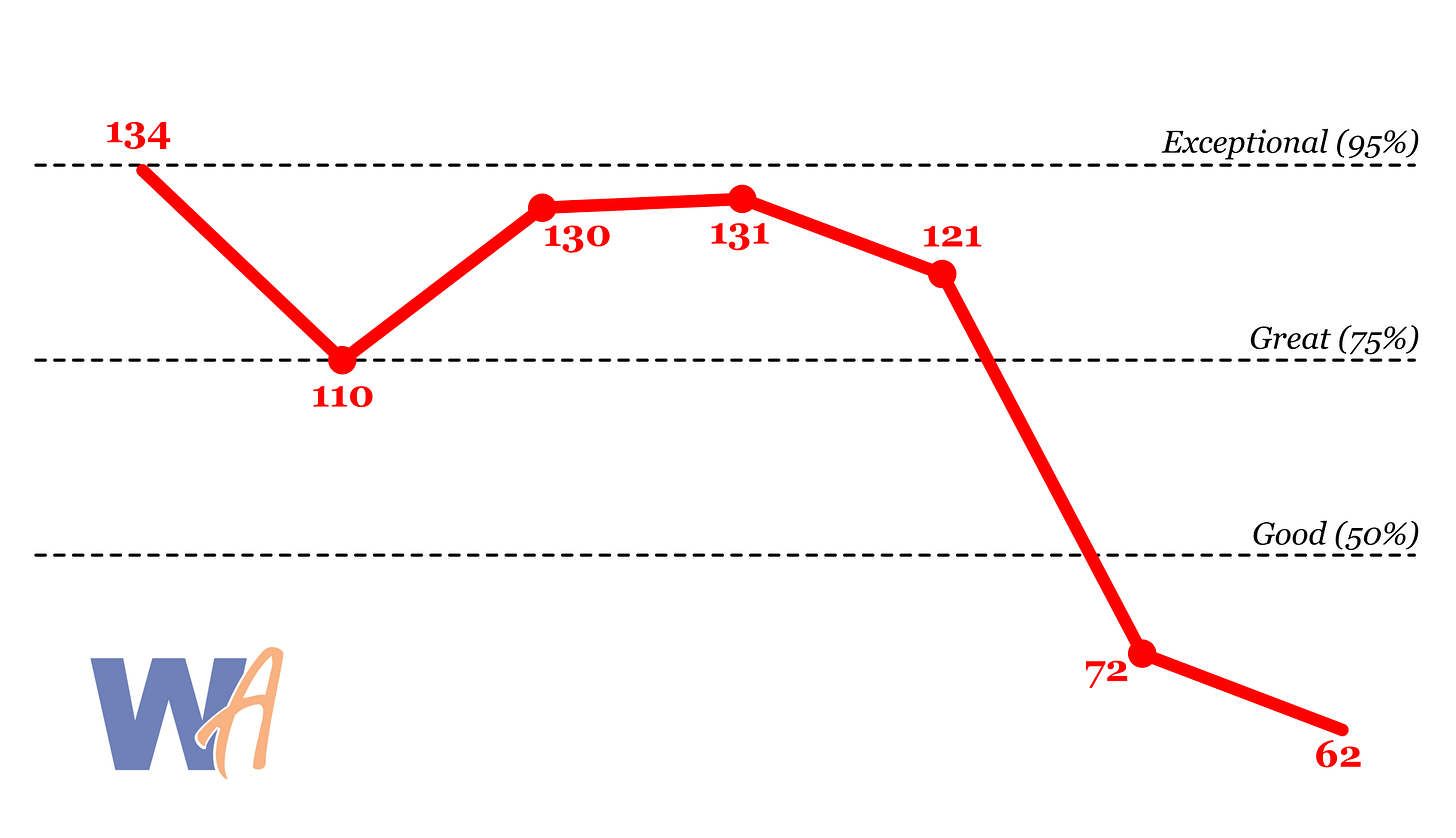Where did the Weapons Go?
A quick look at the importance of wide receivers and why its better to have two good ones, if you can't get three.
Last week we looked at Patrick Mahomes’ P(100) across his career. P(100) is our measure of quarterback performance. It calculates the likelihood that a quarterback will play well enough to win the Super Bowl.
But not everything is the quarterback. We also have another metric – weapon score – that measures how good the players around the quarterback are.
And this metric can tell us something about Mahomes’ drop off as well.
Weapon Score Refresher
Since we’re the only site that uses Weapon Score, it’s always a good time for a refresher on how we calculate the metric.
Weapon score is defined as the receiving yards of a team’s number one receiver, by yards, times the geometric mean of the receptions of a teams number two and three receivers, by receptions.
This entire number is then multiplied by a constant (1/10,000 for an entire season of games) for ease of comparison.
Mahomes’ Career Weapon Score
When Patrick Mahomes came into the league, it was well understood that the Chiefs roster was loaded. The team went 10-6 with journeyman Alex Smith, in Mahomes’ rookie year. The offense was powered by a young Tyreek Hill and a prime Travis Kelce – both of whom exceeded 1,000 yards receiving.
That year, the Chiefs had a weapon score of 134 – an exceptional weapon score, achieved by about 5% of teams. In a typical year, only 1-2 teams each year have a weapon score this high. In some years, no teams will.
For most of the Chiefs’ championship run – the duo of Hill and Kelce kept the chiefs in this range. The low watermark weapon score during the first leg of Mahomes’ career was 110. 110 is the 75th percentile of weapon scores. Only 5 or 6 teams each year will have a weapon score better than 110.
In the last two years, however, the Chiefs weapon score has dropped dramatically. From the 130s to 72, then 62. Meaning who many think is the best quarterback in the league now has some of the worst weapons. Both of these weapon scores, 72 and 62, put the Chiefs in the bottom half of the league.
The Kelce Effect
The biggest driver of this, arguably, is the Chiefs’ over-reliance on an aging tight end as the centerpiece of their offense. Kelce was excellent during his prime, certainly. But offenses are at their best when they are driven by receivers.
Receiver-led offenses are 10-points better, by weapon score, which is enough to jump three or four teams.
Since Patrick Mahomes entered the league, there have been 37 instances of a team ending a season with a tight end as their leading receiver: about 3 per year. Of those, Travis Kelce is by far the most frequent. He has led the Chiefs in yards in six seasons. That’s twice as often as other elite pass-catching tight ends like George Kittle and Mark Andrews.
This is good, historically at least, for Kelce, but ultimately bad for the Chiefs.
The good news is, that it points to a ray of hope for Chiefs fans. As Kelce ages out of the league this year or next, it is probable that Patrick Mahomes and the KC offense actually get better.
The best formations for weapon score?
Perhaps unsurprisingly, the best formations–when it comes to average team weapon score–are all wide receiver led.
Having two strong wide receivers and a pass-catching tight end is your best option. The 62 teams that ended their season with that top 3 averaged a Weapon Score of nearly 100, followed closely by three wide receivers – which averaged a 94 across 69 occurrences.
Two wideouts and a tight end as either your best receiver or your second best receiver is about the same as two wideouts and a running back as your third best pass catcher. But having the running back anywhere besides that last spot is, on average, bad for your offense.
Most teams intend to pass to their receivers – good. About 90% of the teams end with two receivers contributing to their weapon score. Of those that don’t, the average weapon score is 85 – which is tolerable.
But the poor 1-in-50 teams that have only one good receiver AND manage to be led by either a running back or tight end? They average a weapon score of 54. Good for the basement of the league.





